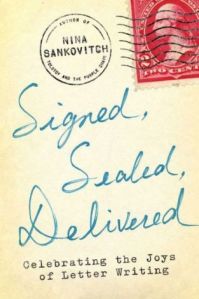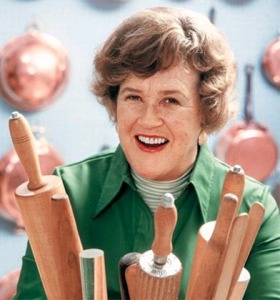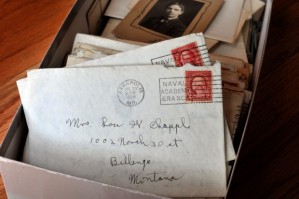
For Nina Sankovitch e-mail, Facebook, texting, and Twitter all have their place, but none can compare to a good, old-fashioned letter. In her follow-up to 2011’s acclaimed Tolstoy and the Purple Chair, the former Evanstonian pays homage to the vanishing art of letter writing with a fascinating journey through the long history of the letter. Praised by 60 Minutes reporter Lesley Stahl as “a joy to read, savor, and remember,” Signed, Sealed, Delivered: Celebrating the Joys of Letter Writing shares the unforgettable letters of mothers, slaves, aristocrats, famous artists, and even Sankovitch’s husband in making a powerful case for the continued importance of letters. On Tuesday, July 15th, you can hear Ms. Sankovitch read from Signed, Sealed, Delivered when she visits EPL’s 1st Floor Community Meeting Room at 7 p.m. In anticipation of her visit, we recently spoke with her via email about preserving the history of everyday people, the trappings of instant response, handwriting, letters from her son, and her next book.
Evanston Public Library: Can you take us inside your writing process for Signed, Sealed, Delivered? What challenges did you face, and how did the experience compare to working on your first book Tolstoy and the Purple Chair?
Nina Sankovitch: I’ve always loved letters and have collected books of letters, or copied letters that I especially liked from books, articles, the internet. My biggest problem in writing Signed, Sealed, Delivered was honing down on the number of letters and letter writers that I could fit into the book! I ended up leaving the love letters of Robert Burns out of the book, but I’ve recently written up a piece about them and posted it to my website.
 Signed, Sealed, Delivered is less of a memoir than Tolstoy & the Purple Chair and more of a history of letter writing, with gems through the ages picked out and mulled over. And yet the book describes many events and moments in my life that were very emotional to write about and made me treasure all the letters I’ve saved – memories saved in and through those letters – even more. My own letters along with my desire to receive more letters from my son off at college provided the framework for the book; all my research into other people’s letters filled in that framework.
Signed, Sealed, Delivered is less of a memoir than Tolstoy & the Purple Chair and more of a history of letter writing, with gems through the ages picked out and mulled over. And yet the book describes many events and moments in my life that were very emotional to write about and made me treasure all the letters I’ve saved – memories saved in and through those letters – even more. My own letters along with my desire to receive more letters from my son off at college provided the framework for the book; all my research into other people’s letters filled in that framework.
EPL: Some of the most memorable letters you include in the book are arguably the ones from common people such as Jourdan Anderson, a newly freed slave writing to his former master. If letter writing is a vanishing art, how will we preserve the history of everyday people?
NS: Most of us will not make it into the history books and yet we can leave our history behind in the letters we write. If we stop writing letters and rely solely on digital communication, I do think we lose the chance to leave our personal, unique history behind. There is something about handwriting, about stationery and stamps and the words we choose to write by hand that is especially evocative of who we are. I read many old letters from archives near and far – in collections I found in libraries, universities, and historical societies – and found history, wisdom, even a real sense of camaraderie with people who had lived centuries before me!
EPL: In Chapter 8 you ask, “With the press of technology, do we allow ourselves space to experience and become? Or have we fallen victim to the expectation of instant response?” Can you discuss how our lives and relationships can benefit from the space and delay inherent in letter writing?
NS: There is so much pressure in texting, emailing, posting to Facebook and Instagram (how many “likes” do I have?). Such stress and pressure does not exist in letter writing. I take time in both writing and reading letters – in savoring the written words – and that time allows me to have both a deeper and a more meaningful appreciation of what is shared through the letter. If a prompt response is needed, yes, I rely on email and text. But for the savoring of shared moments, the next best thing to actually being there is reading about it – in a letter. And when I finish reading a letter, I put it aside for a bit and allow the words to percolate while I go about living my life. I am not glued to the computer or to my phone to communicate. I have letters that give me space to live.
 EPL: What role does a writer’s handwriting play in creating the intimacy and strength of connection found in letters? Is it possible for a typed e-mail to have the same power?
EPL: What role does a writer’s handwriting play in creating the intimacy and strength of connection found in letters? Is it possible for a typed e-mail to have the same power?
NS: Handwriting can be so evocative, especially when it is the writing of a someone you love and you recognize the writing. It is an actual physical – visual – connection between you and another person. But typed letters can also have a lot of personality! Julia Child typed many of her letters with underlines and capitalizations and tons of exclamation points, and her exuberant personality certainly comes through.
EPL: Can any of the virtues of letter writing translate to newer forms of communication like Twitter, texting, and Facebook?
NS: We can keep our emails, texts, tweets as genuine as possible – and there can certainly be virtue in brevity! Any form of communication – connection – is to be applauded when it is from one person meant especially for one other.
EPL: As you move your son Peter into his Harvard dorm room at the end of Chapter 1, you write, “I left a present tucked into his bags of books and clothes: a box of ivory note cards with matching stamped envelopes.” How often has Peter written from college? How often do you still write letters, and with whom do you correspond?
NS: Peter did write to me, most often to commemorate a special occasion, such as my birthday. I write to my children, to my parents and sister and friends who live a distance away. I write thank you cards for dinners, coffees, presents, or even just to let someone know how special they are to me. I wrote condolence letters to share special memories of the person that has died, to show that memories live on and on. I write for my own comfort – we can all live on through others’ remembrances of us – as well as to offer some remedy against the sorrows of the grieving person.
 EPL: What do you hope readers will take away from Signed, Sealed, Delivered?
EPL: What do you hope readers will take away from Signed, Sealed, Delivered?
NS: I hope that readers will be inspired to become letter writers, and letter savers. So many people have shared stories with me of family letters found in attics and boxes. Those letters mean so much to them now, preserving family history or enlightening family history – or just providing laughs and tears and wonder. I’ve heard stories of saved letters from old boyfriends or best friends or faraway cousins and how those letters today bring joy to the reader. If we can hand such treasures on to our own children and friends and family, shouldn’t we try to save and preserve the letters we are lucky enough to have received?
EPL: What are your plans now that Signed, Sealed, Delivered has been published? Do you have any new projects in the works? Can we look forward to another book sometime in the future?
NS: I am working on a book about the Lowells of Massachusetts. It will not only be a history of the wildly energetic and sometimes eccentric and always interesting Lowell clan but also a history of New England from the 1600s through the 1900s. St. Martin’s Press is my new publisher, and I am very excited about the project – research includes reading boxes upon boxes of old letters!
Interview by Russell J.
